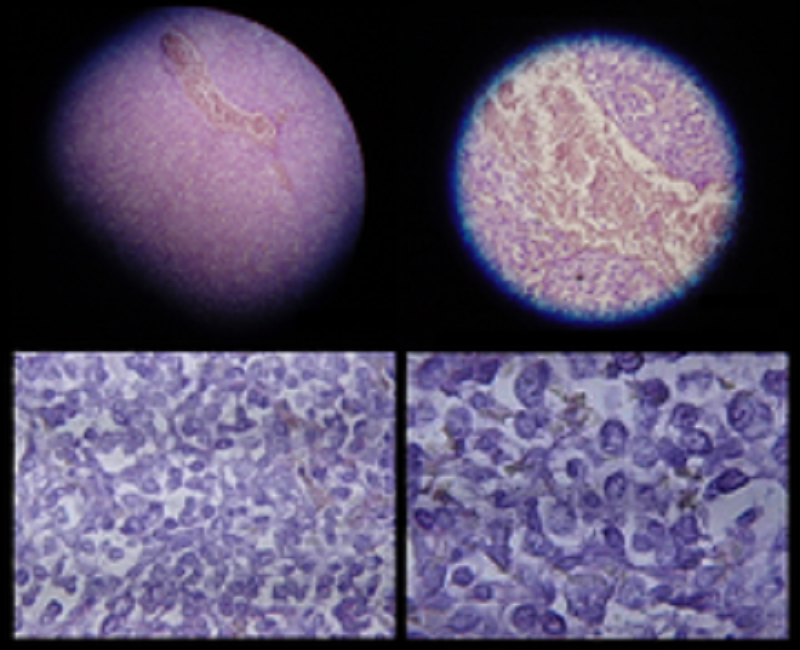What is Biphasic Mesothelioma?

Biphasic mesothelioma is the second-most common cell type of asbestos cancer. About 20 to 30 percent of all mesothelioma cases are usual onset biphasic. Due to its cell composition, biphasic mesothelioma can be very difficult to diagnose and is easily mistaken for other forms of cancer. Second opinions are frequently recommended for patients diagnosed with biphasic mesothelioma.
Characteristics of Biphasic Mesothelioma
All forms of mesothelioma have three histological cell types — epithelioid, sarcomatoid and biphasic. Tumors that are defined as biphasic are made up of both epithelial cells and sarcomatoid cells. For that reason, biphasic is also referred to as mixed mesothelioma.
Knowing the ratio of epithelioid cells to sarcomatoid cells is very important in biphasic cases. Epithelioid cells respond best to treatment. Sarcomatoid cells are much less treatable and have a poorer prognosis. Doctors decide how aggressive the course of treatment should be based on which type of cell is dominant.
For example, a patient with biphasic tumors with predominantly epithelioid cells might be a candidate for surgery. However, biphasic tumors with sarcomatoid-dominant cells are generally not recommended for a surgical approach.
Biphasic mesothelioma occurs most frequently in the pleural lining the lungs but is also found in cases of peritoneal, pericardial and testicular mesothelioma. Like all other forms of the disease, biphasic patients have a better prognosis if the mesothelioma is detected early. However, the generalized symptoms can mimic a wide variety of benign conditions and other cancers. Many patients aren’t diagnosed until they are in the late stages of biphasic mesothelioma.
Diagnosis
Though both types of malignant cells are found within biphasic patients, they are often in different areas of the tumor. That makes them particularly tricky to diagnose. A typical biopsy might detect only one of the two types of cells in a biphasic tissue sample. This is problematic because biphasic cells can mimic numerous other forms of cancer, such as synovial sarcomas, carcinosarcomas, metastatic adenocarcinoma, skeletal tumors and pulmonary blastoma of the lung.
Doctors use multiple methods to diagnose biphasic mesothelioma, including:
Immunohistochemistry
 Pathologists use immunohistochemistry to aid in the diagnosis of biphasic cancer. Immunohistochemistry involves using a dye (also called a stain) to look for the presence of proteins that are usually found in mesothelioma cells. These are called immunohistochemical markers. The presence of certain markers such as cytokeratin 5/6, WT-1, calretinin, D2-40 and glypican-1 can be suggestive of mesothelioma over other suspected forms of cancer.
Pathologists use immunohistochemistry to aid in the diagnosis of biphasic cancer. Immunohistochemistry involves using a dye (also called a stain) to look for the presence of proteins that are usually found in mesothelioma cells. These are called immunohistochemical markers. The presence of certain markers such as cytokeratin 5/6, WT-1, calretinin, D2-40 and glypican-1 can be suggestive of mesothelioma over other suspected forms of cancer.
But according to a 2006 study in the Journal of Clinical Pathology, immunohistochemistry alone cannot confirm a biphasic cancer diagnosis because no single marker reliably distinguishes all cases. That conclusion was backed by a 2012 study by the Department of Pathology at the Thessaloniki (Greece) General Hospital, which found that using immunohistochemical and morphological methods could not definitively clarify whether a patient suffered from reactive mesothelial proliferations or biphasic pleural mesothelioma.
Imaging
Reviewing images such as X-rays, CT scans and PET scans gives doctors an idea of the extent and size of tumors. Imaging is a good starting point for diagnosing, staging and monitoring the progress of a patient.
Needle biopsy
Doctors try to use the least invasive methods possible to diagnose patients with mesothelioma. Needle biopsies involve the insertion of a hollow needle into the affected area to extract fluid or tissue for analysis. However, the small sample size does not make a needle biopsy the best method to confirm a diagnosis.
A study published in the August 2016 Case Reports in Pulmonology found that it took both a CT-guided needle biopsy and surgery to gain a large enough sample to diagnose a 41-year-old man with biphasic mesothelioma. Sarcomatoid cells showed up in his initial sample, but later surgery revealed the presence of epithelioid cells and confirmed a biphasic diagnosis. Researchers also found that there wasn’t a strong enough presence of immunohistochemical markers to differentiate the patient’s pleural sarcomatoid mesothelioma from other malignancies.
Surgery
 Because epithelioid cells and sarcomatoid cells are often scattered in a biphasic patient’s tumor(s), surgery is the most reliable way to obtain a sufficient sample for biopsy. Doctors can remove tissue from multiple parts of the tumor, increasing the chances of finding both types of cells.
Because epithelioid cells and sarcomatoid cells are often scattered in a biphasic patient’s tumor(s), surgery is the most reliable way to obtain a sufficient sample for biopsy. Doctors can remove tissue from multiple parts of the tumor, increasing the chances of finding both types of cells.
The type of procedure used depends on the location of the disease. Most biphasic cases are pleural. In those cases, doctors might use endoscopic methods such as a thoracoscopy or mediastinoscopy. Patients with suspected cases of peritoneal biphasic mesothelioma might have a laparoscopy to examine the abdominal cavity.
MESOMARK
A Japanese-based biotech company developed an in vitro test for malignant mesothelioma called MESOMARK. The test measures the amount of SMRP (soluble mesothelin related peptides) in a patient’s bloodstream. Researchers believe MESOMARK could be useful for monitoring patients with biphasic cancer, but they caution that it should only be used in conjunction with other clinical methods.
Second Opinions
Getting a second opinion for a cancer diagnosis should be seriously considered. Because it’s so difficult to know whether a biopsy captured both cell types, a second opinion might encourage patients to explore other diagnostic procedures and treatment options.
In addition, the non-specific nature of the symptoms means that this type of cancer is often misdiagnosed. A study published in the March 2011 Journal of Thoracic Oncology found that of 19 patients initially diagnosed, only five were correctly diagnosed at final review. Most of those patients were initially diagnosed as biphasic before extrapleural pneumonectomy (surgical removal of a lung) with a thoracoscopy or CT scan.
A second opinion is also important because mesothelioma is such a rare disease, with only about 3,000 new cases every year in the U.S. Many seasoned oncologists go their entire careers without running across a case of this type of cancer. Patients need to find someone who understands the disease and has treated it before.
At the very least, a second opinion can provide biphasic patients with peace of mind knowing that they are doing everything they can to ensure that they receive appropriate medical care.
Symptoms
Biphasic mesothelioma is most common in the pleural (lung) area in the chest cavity. The symptoms include:
- Pleural effusion (fluid build-up around the lungs)
- Chest pain
- Shortness of breath
- Difficulty swallowing
- Swollen arms and face
- Lower back pain
Symptoms of biphasic mesothelioma may not emerge for 15 to 60 years after asbestos exposure. Many patients are not diagnosed until they are in the late stages of biphasic mesothelioma and have limited treatment options.
Treatment Options
Treatment decisions for biphasic mesothelioma depend upon whether epithelioid or sarcomatoid cells are more prevalent in the tumor. Malignant epithelioid cells are much more responsive to treatment than sarcomatoid cells.
Patients with more epithelial cells have more treatment options and a better prognosis. Surgery, chemotherapy and radiation therapy may all be recommended courses of treatment. These treatments can be effective in attacking the epithelioid cells, but they often do not have an impact on sarcomatoid cells. For that reason, a sarcomatoid-dominant form of biphasic mesothelioma is often treated with palliative care to relieve the symptoms of the deadly asbestos cancer.
Palliative care for biphasic mesothelioma
Patients who opt for palliative care may use a variety of cancer treatment methods to improve quality of life during their battle with biphasic mesothelioma, such as:
- Pleurodesis to relieve fluid build-up that makes breathing painful
- Radiation therapy to shrink tumors and improve comfort
- Chemotherapy to try to kill more biphasic cancer cells
- Pain medications
- Homeopathic treatments
- Chiropractic care
- Vitamin supplements
According to the American Cancer Society, researchers are exploring a variety of new ways to treat this disease. Some are already being tested in clinical trials, and others are still in earlier developmental stages. Those potential treatment options include:
- Photodynamic therapy: A light-activated drug that tends to adhere to cancer cells is injected into the body. During surgery, doctors then shine a special light into the chest, which activates the drug to kill the cancer cells.
- Targeted therapy: In targeted therapy, specific drugs are given to target the patient’s cancer cells while leaving the healthy cells alone. Targeted therapy is thought to produce fewer side effects than traditional chemotherapy.
- Immunotherapy: Doctors use drugs to try to stimulate the patient’s own immune system to kill cells.
- Gene therapy: Laboratory-modified genes are inserted to trigger changes in cancer cells in order to make them easier to kill. This process is in the very early stages of development and is currently being tested only on diseases that have no cure like mesothelioma.
- Vaccines: A variety of potential vaccines are being studied as another way to encourage the body’s immune system to attack biphasic mesothelioma and other cancers.
Mesothelioma Prognosis & Deaths
 For biphasic patients with predominantly epithelial cells, the outlook is brighter than for those with more sarcomatoid cells. Like all forms of mesothelioma, early detection and the stage of the disease upon diagnosis is key.
For biphasic patients with predominantly epithelial cells, the outlook is brighter than for those with more sarcomatoid cells. Like all forms of mesothelioma, early detection and the stage of the disease upon diagnosis is key.
Unfortunately, most people are not diagnosed until stages 3 or 4.
By that time, the prognosis is 6 to 8 months. Patients in earlier stages who receive more aggressive treatment may live for up to one year following diagnosis. Individualized factors such as age, overall health and lifestyle choices may also play a role in the life expectancy for patients.
What Causes Mesothelioma?
The only known cause this type of cancer is asbestos exposure. People who worked with or were in close proximity of asbestos materials may have inhaled or swallowed the carcinogenic fibers. It’s also possible for family members of those who worked around asbestos to develop meso as a result of secondhand exposure.
Once inhaled or ingested, asbestos fibers may get stuck in the tissues lining the lungs, chest wall, abdominal cavity, heart or testicles. Over time, that may cause healthy cells to mutate and become malignant.
Asbestos fibers are invisible. There’s no way for people to know exactly how much of the substance they were exposed to. But that doesn’t matter. Research has shown that there is no safe level of asbestos exposure. A single exposure could eventually result in mesothelioma. However, most biphasic cases involve older patients who worked near asbestos for prolonged periods of time.
It’s important to remember that mesothelioma cancer can have a latency period of up to 60 years following exposure to asbestos. People should not discount any new respiratory symptoms as minor illnesses if they have a history of asbestos exposure. There is no cure for mesothelioma, but catching it in the earlier stages has the potential to prolong life.
Occupational Exposure to Asbestos
Countless numbers of people around the world have been exposed to asbestos, either at work, at home, during military service, and even in schools and other public buildings. Disturbingly, many companies that manufactured asbestos knew that the mineral could cause health problems but failed to warn the public of the hazards.
By far, the most common source of asbestos exposure occurs on the job. Many occupations are associated with a high risk of exposure, such as:
- Miners
- Factory workers
- Construction workers
- Firefighters
- Insulation manufacturers and installers
- Plumbers
- Electricians
- Railroad workers
- Mechanics and automotive workers
- Roofers
- Military service members
- Power plant workers
- Boiler room workers
- Shipbuilders
- Mill workers
- Laborers
- Demolition workers
Asbestos is also found in a number of household, commercial and building materials. Although restrictions have been placed on some asbestos-containing materials, there is no universal ban on asbestos in the United States.
Getting Financial Relief After a Mesothelioma Diagnosis
Biphasic mesothelioma is a rare and aggressive disease. Getting proper medical care is vital to achieving the best prognosis. But specialists are not found in every American city. Many patients and their caregivers have to travel considerable distances in order to receive care, which is both expensive and exhausting.
Fortunately, financial help is available for patients with asbestos cancer and their families. Monetary assistance can come from a variety of sources, including asbestos trust fund claims, asbestos lawsuits, veterans’ disability payments, Social Security disability benefits and workers’ compensation benefits. Patients may also qualify for travel grants to help pay for trips to top medical centers.
To obtain the best financial recovery possible, it’s essential to speak with an experienced mesothelioma attorney. Mesothelioma claims are very complex. Patients need an attorney who can identify the at-fault parties and hold them accountable for their negligence.
Compensation can help cover expenses such as:
- Past, current and future medical expenses (e.g., surgery, hospital bills, hospice care, prescription medications, doctor’s visits)
- Lost wages
- Lost earning capacity
- Pain and suffering
- Funeral and burial costs
- Wrongful death awards for the family’s loss
The process starts with a free consultation with a skilled mesothelioma lawyer. During the meeting, the lawyer will ask questions and review documents such as the patient’s medical records and employment history. Then patients will learn about their legal options.
Contact us now to get the sympathetic and detailed legal advice you deserve during your struggle.
Sources:
